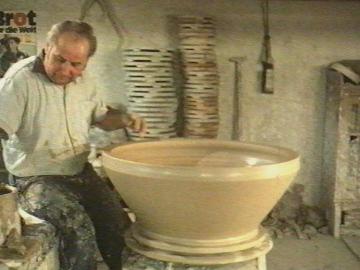

The first step in clay preparation is the soaking process, which lasts some weeks in several clay pans until the clay is moist.
Depending on what the clay body is used for different clays, sand and grog are layered to a huge pile. Cutting this pile vertically provides a first mixing when it is shoveled into the pugmill.
Eberhard: "It is most important to mix the clay thoroughly. Each of the three layers of clay has been covered with quarz sand to enable an even mixture. It's senseless to make a pile of short clay and cover it with a pile of plastic clay. Everything has to be layered evenly to mix the sand with the clays. Then it goes into the pugmill.
Each layer is covered with sand; if you intend to make big pots you add some grog, which gives strenght to the body. The bigger the pots are the more strenght the clay body got to have. On the other hand you have to prepare a very fine and clean body for thin, little pieces.
Here is a nice old tool for potters called "Tonschabe" or "Tonschneide" ('clay cutter or scraper'). In past times the women sat there on the pile and scraped the clay, I have seen it as a child. There was no sort of pugmill at this time and the clay had to be scraped."


At the lower level of the pugmill two others were occupied with cutting the bricks and placing them on the elevator which lifts them to the drying area in the second floor.
Here again two helpers have to receive and stack the bricks properly for drying. But for us Christel manages all work alone.
250 bricks are necessary for every firing. The pavement of the kiln area is also covered with them. The most beautiful ones cover the entrance area of the workshop.

Throwing and Glazing
The pots are thrown on wooden bats to simplify the taking off the wheel. The accurate height is determined by a pointing stick.
Christel: "My opinion is, that there are some fine traditional forms, which should not be changed in any way. They still function very good. Other forms are not longer needed for any purposes. And I have some new ideas for using this technology for architectural ceramics, beautiful park banks, where the large surface is flashed from the flames and enables a nice splendidness. Small pots cannot reflect the processes going on in the kiln. I would like to try it on other forms, e.g. big slabs, which I find very inspiring. I also like the old roof-tiles, handformed roof-tiles. After several firings they develop a distinctive live and beauty."

Eberhard wedges 30 kg (66 pounds) of clay for a planting bowl of 70 cm height.


Everything was judged by realisation of the production plan from the authorities - and never have I been able to fulfil it. So they had a poor opinion of me. Missing the plan meant having been lazy. All was just valued by turnover. But I only got four Marks for a pigs trough, which was hard work to make, more work then the others did, who got much more for their little pots, and I think this was really unfair.
So I never met the production target and thus never got acceptance. I strived for a little bit more quality in production and the involvement of new ideas, but it was very hard.
The production of simple and straight pots, which I always wanted to make, was 'punished' again, because every sort of decoration on the pot raised the price fixed by the government. Thus the simple pot, which I really wanted to make was the cheapest pot and I never reached a reasonable turnover."
The two kilns had been fired alternating every two or three weeks. To produce this amount of pots three assistants used to work here on the wedging tables and the wheels, pulled handles and finished pots. Two extra workers packed and unpacked the kilns and prepared the clay.
Christel:" The definitive end of using this kilns for firing pots seems to be in sight. The production cycle of a firing every month is already gone - firing just once a year makes everything different. The waste heat from the kilns is no longer utilized well and the cycle is interrupted.
Selling pots now on pottery markets needs much more attention and time, but I really like it. You increase your own value very much compared to loading your ware on the truck and off it goes. You can have a totally different relationship to the customer and I like that."
